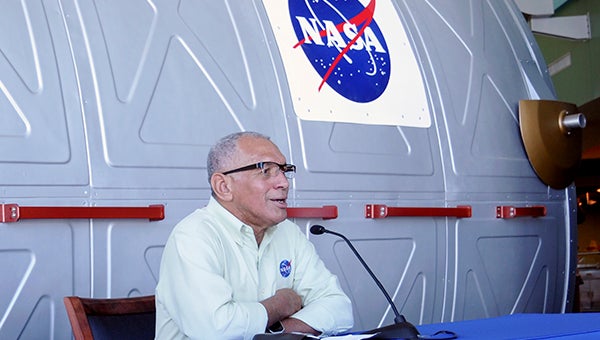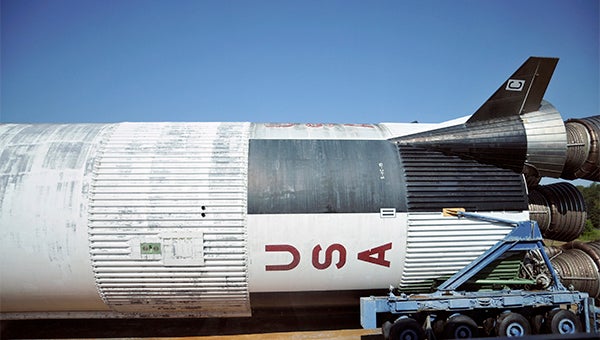NASA Administrator speaks at INFINITY
Published 7:00 am Tuesday, July 5, 2016

NASA Administrator Charles Bolden spoke at a press
conference Saturday about upcoming projects at Stennis Space Center.
Photo by Julia Arenstam
“You have to come through Mississippi in order to get to space,” said NASA Administrator Charles Bolden at a press conference held Saturday at the INFINITY Science Center.
Bolden stopped at the INFINITY center Saturday after touring Stennis Space Center before speaking at the Essence Festival in New Orleans.
“What I hope to do is to show young people that if they’re willing to work hard, to study hard and not be afraid of failure… that’s what I hope to tell them and that’s what I have done in my career,” said Bolden.
Currently, NASA is developing a new Space Launch System rocket that will be tested at Stennis Space Center, said Bolden.
The SLS rocket will be paired with the new Orion spacecraft, first tested in December 2014, said Bolden.
Orion has been developed alongside the SLS to send humans further into space than ever before, said Bolden.
The SLS systems will be tested at Stennis. This will be the first time since Apollo that engines intended to carry humans beyond orbit are test-fired, said Bolden.
“Mars is really critical for us because one, it’s the most important planet in our solar system next to Earth, and two, because we believe it was at one time very similar to Earth,” said Bolden.
Traveling to Mars and studying its science, changing climate and what has happened to the planet will help scientists on Earth, said Bolden.
“If you find life on another planet, that changes our whole perspective of our human existence,” said Bolden.
The 2016 class of NASA astronauts had over 18,300 applicants, said Bolden. He attributed this record-breaking number to the excitement about Mars and the future of NASA.
Before the press conference, Bolden met a family from the Czech Republic who were visiting the INFINITY Center.
“People don’t just do that on a whim,” said Bolden who spoke with the mother about how they planned the stop at the tourist attraction as part of their trip.
With increasing excitement, the Curiosity rover has been on Mars for several years and is still finding something new every day, said Bolden.
Last year, the rover found flows of water that could prove the existence of microbes, which could provide proof of former or current life on the planet, said Bolden.
“It has given us renewed hope that we will find life itself, if not at least signs of life on Mars,” said Bolden.
NASA is looking to test the Orion spacecraft with the SLS system as early as November 2018, in another unmanned mission, said Bolden.
They will then send the first crewed mission between 2021 and 2023. Many of the new astronaut applicants will be competing for a seat on that mission, said Bolden.
Bolden stressed the importance of Stennis in developing new technology, including 3D printed engines, said Bolden.
“Stennis is helping us to determine what is feasible for future flights, its future is bright,” said Bolden.
With the hopeful discovery of microbes on Mars, scientists will be able to grow food and create building materials out of Martian soil, rather than transport the materials from Earth, as well as create breathable oxygen from the carbon dioxide in Mars’ atmosphere, said Bolden.
“If we find real microbes, it helps us for our planning of the future in putting humans there,” said Bolden.
Between 2019 and 2021, NASA is planning to launch a robotic vehicle to an asteroid, remove a large boulder from the outer lying asteroid, and slowly pull it out of the sun’s orbit and force it to get closer to the moon, thereby creating an artificial satellite for the moon, said Bolden.
The asteroid will then be studied to see if it can be mined by commercial entities, said Bolden.
We are, “doing what NASA is supposed to do which is doing the game-changing technology and development that then allows industry, and academia, and entrepreneurs to come on and use that tech to increase our own economy,” said Bolden.
On Monday July 4, at about 10:53 p.m. the solar-powered satellite Juno entered into Jupiter’s orbit after a five-year trip to the outer planet, announced Bolden.
Additionally, on Wednesday July 6, Dr. Kate Rubins, a member of the 2009 astronaut class, will be launching a six-month mission to the International Space Station along with Russian and Japanese astronauts, said Bolden.

As NASA Administrator Charles Bolden spoke to the press Saturday, he looked out onto the retired Saturn V rocket that had recently been brought to the INFINITY Science Center.
Photo by Julia Arenstam






